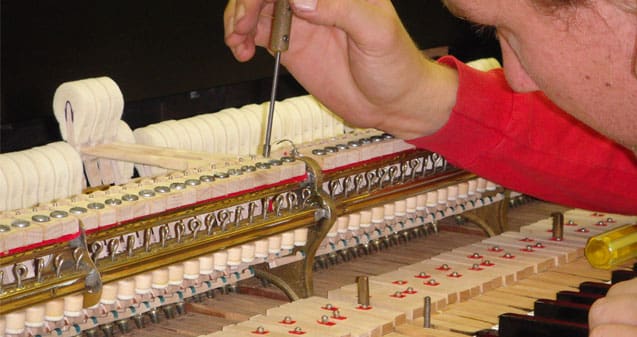
“But the fact that it can accommodate all those different key centers, the fact that it can play anything fairly adequately in tune, is really something.” “Compared to an a cappella choir, for instance.” He falls silent again for a moment, his arms folded over his off-white Wallace Beery shirt, then seems to rouse himself from some distance. “A tuned piano is very out of tune,” he pronounces. He has reached the decision that he is finished. Setting down the hammer, he folds his hands in his lap and stares at the soundboard, the wires and brass, the “action.” He tugs at his beard and sighs again, puts away his hammer, and wipes his hands on his Levis.

If not appropriate, at least good-natured.” He smiles. The kind of awakeness that allows you to be appropriate to whatever moment you’re in. The note bends, the hammer teases it into vibration with a D flat.

The silence is filled with the repetitive thumping of a muted F sharp. “Perfect sanity!” He pauses for a long beat. He returns his attention to the process of tuning the Fischer and changes the subject–or maybe he hasn’t. In response to his listener’s questioning look he illustrates vocally, “What you’ll hear is wah wah wah WAH WAH WAH wah wah wah WAH WAH WAH–see?” “Most of the time we don’t listen to pitch, we listen to what are called beats.” Here he goes into a discussion that begins technically with specific measurements of a piano wire at 446 cycles per second and one at 440 cps, and the vibrations of the two wires bouncing off each other at the rate of the difference in cps. The names of the primarily Japanese congregation are written on the covers: Nakayama, Watanabe, etc. A lectern holds a Bible the size of a boom box, and hymnals are piled on the chairs. A four-foot brass crucifix dominates above a slate slab and tall candles. Behind where he is seated on the piano bench is the altar of the church. Hunt twines his fingers through his beard. You have to know the physics that are involved.” You don’t determine this by pitch consciousness–nobody could tune a piano by pitch consciousness alone. “Out of tune compared to true intonation–true intonation being the way two violinists would play. You do that by making most of the intervals slightly out of tune.” He peers at his listener expectantly, looking for comprehension or puzzlement, interest or boredom. You don’t lean it in any direction, any particular key. Which is a compromise which allows you to play in all 12 key centers equidistantly. “What you have to do,” he says as he weaves a ribbon of red felt between the piano wires, “is set what’s called the equal temperament. The beard beneath a carefully shaved mustache evokes, on the heels of Santa Claus, Alexander Solzhenitsyn and new-age guru Ram Dass (ne Richard Alpert). His eyes are steady and clear blue behind rimless glasses, and wisps of white hair ring his bald pate. The most striking physical aspect of Hunt is the tangle of white beard that juts from his chin like a coral formation.

During the late 60s and early 70s he also accompanied a long list of popular performers, including Tony Bennett, Frank Sinatra, Liza Minnelli, and Liberace.

Before that he was a student of Edward Kleinhammer, played with Gunther Schuller, contributed alto and tenor recorder for an album (Ripples) with the New Cambrian Society quintet, and was a free-lance bass-trombone player doing primarily opera and ballet work in the Chicago area.
#Piano tuner chicago professional
Hunt, at 43, has been a professional piano tuner for 16 years. “It’s the one thing a piano doesn’t have.” “Infinitely flexible intonation,” he repeats and sighs, setting down the hammer. He strikes the key again and pulls on the hammer, and the note slides up a minute degree. He pulls downward on a tuning hammer (which looks like a socket wrench) and taps middle C with his left forefinger. “When you’ve got singers or you’ve got trombone players or violinists, when they’re playing music–in the moment–they’re constantly adjusting their intonational aspects to the requirements of the moment.” As he speaks, Hunt has his ear to the soundboard of an upright Fischer in the basement of the Christ Church of Chicago at Paulina and Cullom. He looks like Santa Claus is the first thing one thinks. “Perfect intonation is infinitely flexible.” As with many things Francis Hunt says about music, it is not immediately clear whether he is speaking technically or metaphorically, about literal acoustic theory or an observation on the human spirit.
#Piano tuner chicago series
Sommelier Series (paid sponsored content).


 0 kommentar(er)
0 kommentar(er)
